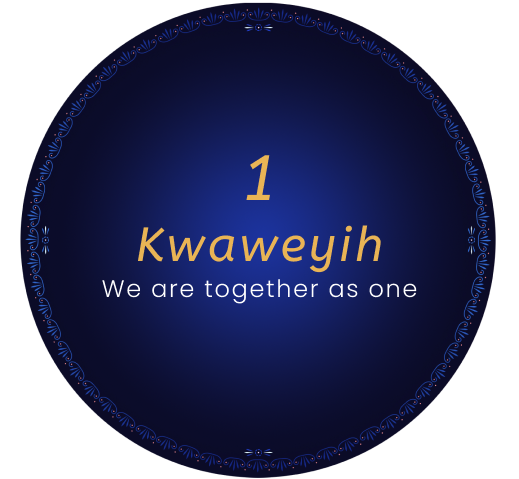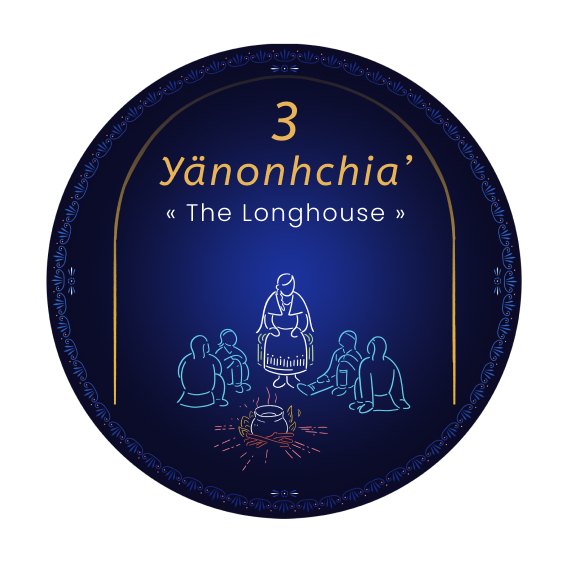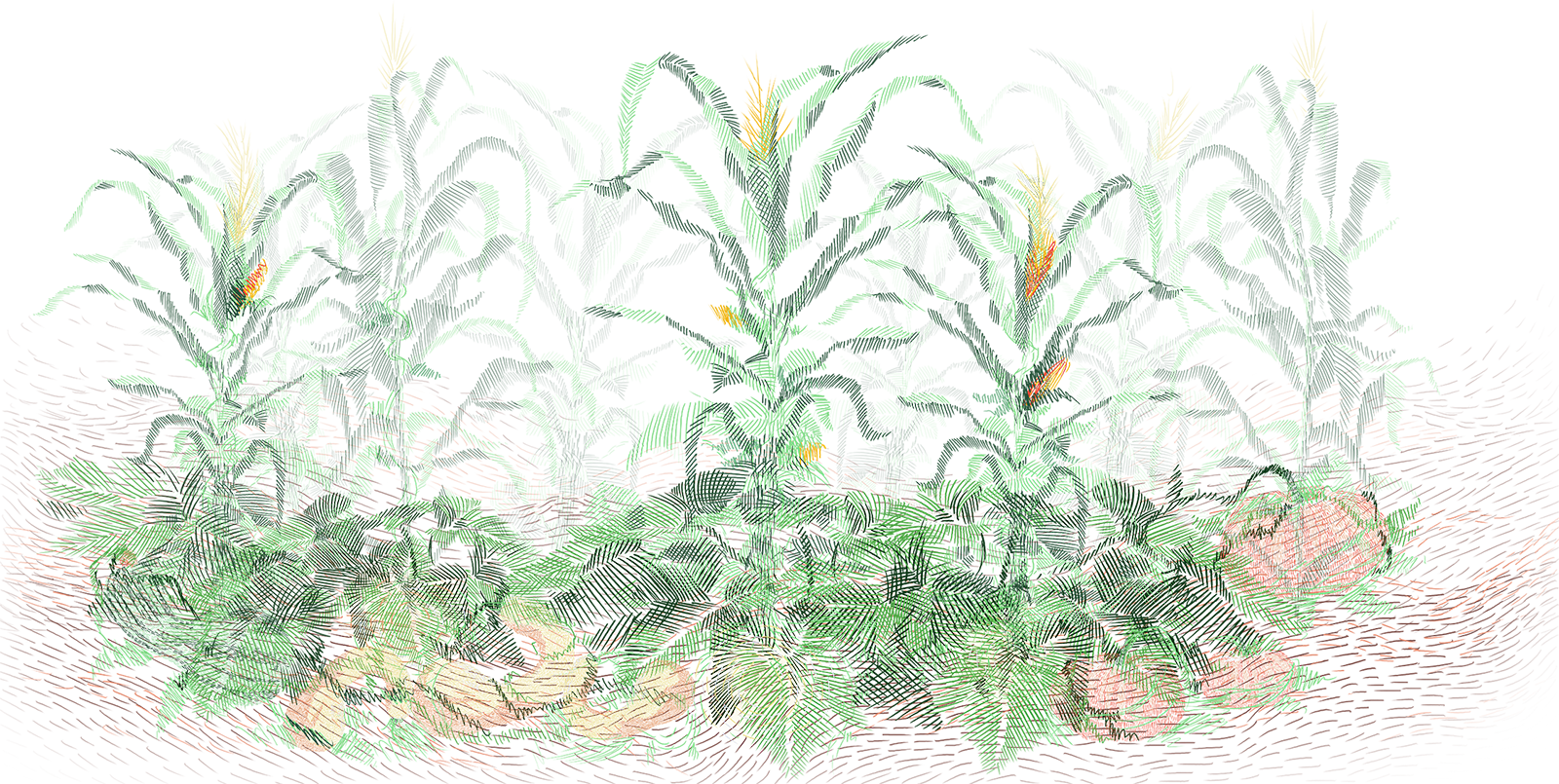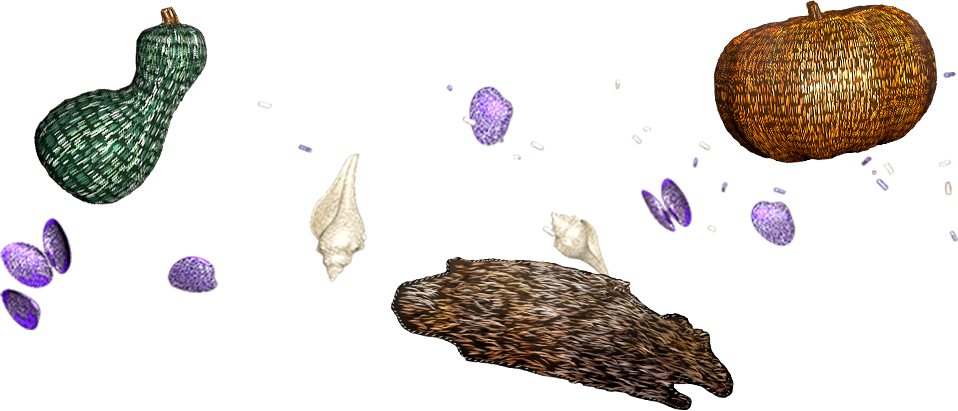
The Philosophy of the Circle
As the historian and philosopher George E. Sioui said so well, the Wendat are a Circle Society. A circular understanding of the world is one in which all the beings within it are equal and interdependent, and where humans are one of the many life forms that participate in this harmonious unity.
By living in symbiosis with all the world’s inhabitants—plants, animals, etc.—strong bonds of reciprocity are formed. The traditional customs and knowledge bear witness to the patience of these longstanding relationships with the natural world. As such, we dance in a counter-clockwise direction, like the rotation of the earth, and the growth of beans.
This vision is embedded in the Wendat language when we say “I’ve caught up with the day of my birth so many times.” We can see the seasonal cycles that we’ve come through. The circle is also a way of recognizing that everything comes back, moon after moon: flora, fruits, migratory birds, harvests, death and birth.

The Wendat Creation Story
Once, long ago, our Wendat ancestors lived in the Sky World. One day, a woman named Yäa’tayenhtsihk was searching for a remedy, close to the Tree of Life, when she fell to the Water World.
Protected from this fall by two geese, she survived thanks to the care of the Counsel of Animals.
Several animals dove into the perilous depths, and eventually the earth that had fallen from the sky was brought back from the very bottom of the waters, and spread out upon the back of the Great Turtle. This became the Great Island.
Little Turtle created the sun, the moon and the stars. Yäa’tayenhtsihk had a daughter, who had twins of contrary demeanours. Between chaos and harmony, they created the world as we know it, upon this island. After a duel, Iouske’a, the twin of order, defeated Tawihskaron’, the twin of chaos. He ended the cycle of creation by shaping and breathing life into humans, whom he then taught how to live well.

On the Back of the Great Turtle
Turtle Island is the name that we give North America today.
Other origin stories also refer to Turtle Island, a concept that is shared by several of the First Nations from this territory.

Matricentric Society
Women are at the centre of our society, a concept embodied in the longhouse. Yänonhchia’ is the place of women and of the fire of cultural transmission, of which they are the guardians. Women direct and organize social life, preparing and transforming the materials necessary for life and for trade. When night comes, during the cold season, we dance, play, and gather around these fires, as the stories told by elders are intertwined with lullabies.

Clans
As in the creation story, animals have an important significance for us, and they represent the family clans. This is our way of paying homage. In our matricentric society, children belong to the clan of their mothers, much like a family name that they will keep their whole lives. Each longhouse holds a single clan, and men move to the longhouse to be with their wives.
The clan takes on a primary importance, such that maternal aunts are also called “mother”.
Today, the descendants of only four clans remain in Wendake: Deer, Turtle, Bear and Wolf. But there were once many others: Porcupine, Beaver, Hawk, and Snake.

Canada comes from the word Yändata’. Villages were once situated around a long, steep slope near a stream of water and arable land that facilitated travel and allowed for agriculture. The palisades offered protection.

The 3 Sisters
Corn, squash and beans are known as the “three sisters”, sown together in small mounds of earth. Their name comes from the way they work together—cultivated as a trio, they create ideal growing conditions, each one for the other. This process is known as “permaculture’’. Women also grew sunflowers.

Guardians of Peace
This example of partnership resembles the numerous alliances and reciprocal protections that were maintained by the men in their commercial exchanges with several nations in order to ensure the peace and well-being of the society. Men cultivated tobacco which served, among other things, for offerings and rituals, including that of preparing the mind to see clearly when war was declared.

Wampum Belts
Wampum belts served as a reminder and validation of diplomatic relationships. These were made from rows of beads, fashioned out of purple and white shells and sewn into cords that formed specific motifs to complement the words of orators or diplomats, or to institute an agreement. They also served to establish military and/or commercial alliances, highlight or commemorate notable events, and even to declare war.

Giving Thanks to Creation
Even though there were interruptions in the transmission of our culture and our customs, we never ceased to be grateful.
We thank each other, as people, and we thank the earth, the waters, the fish, the medicine and food plants, the berries, the trees, the animals, the birds, the winds, the thunder, the sun, the moon, the stars, the wisdom guides and the Creator.
Our ritual calendar follows the cycle of the seasons, and we come together to give our thanks by burning tobacco that we’ve grown, by singing, dancing, and sharing a meal.
Wendat Language
Five words from the Wendat language are illuminated in the tableaux to illustrate these relationships and to highlight our pride in rediscovering our ancestral language after so many years of dormancy.
Awen’- Water
Onhwentsa’- The world
Yarha’- The forest
Yentsonh – The fish
Yaronhia’- The sky
After several linguistic revitalization efforts, our Wendat Nation is supporting the rebirth and spread of onywawenda’, our language, through the training of teachers, as well as pedagogical and technological tools.



Responsibilities
We are intimately connected to the living world and all its life forms, and our ways of giving thanks remind us of our responsibility to life itself. Duties of humility, respect, love, generosity, protection and conservation—these words of gratitude encourage us to continue living a good life for as long as possible.

Strawberries and Crafts
Strawberries have a great importance for us, as they’re the first berry to ripen, and they show us that the summer has arrived. We celebrate their return, and the medicine they bring. Wendat women were very talented artisans, renowned particularly in the 18th and 19th centuries for their naturally dyed porcupine quill works and moose hair embroidery with handcrafted colours. Motifs of flowers, strawberries, contours and scenes of daily life are depicted upon clothing, jewelry and various objects. Their art gained great renown and the embroidered pieces offered to dignitaries were the pride of the Wendat. Lawinonkie Marguerite Vincent is officially recognized as a historical figure in Quebec for her significant contributions to the transmission and development of traditional knowledge.

Expertise
Our ancestors understood this territory and travelled great distances to share their words, exchange goods, hunt, fish and trap. Makers of cedar and bark canoes, snowshoes, fishing nets, baskets, pottery, moccasins and clothing covered in embroidery, they gave the following generations the inspiration to pursue such activities in innovative ways.

The world of stars shines brightly to remind us where we’ve come from and where we’re going. The immensity of the world is summoned within this luminous space for a moment of poetic beauty, where dreams take shape.
The Pleiades
Even though nearly all words are feminine in the Wendat language, the word for “star” is an exception. The Pleiades are called “Hotihwatsira’” or “they are a family”. This group of stars comes back each winter to remind us that a new yearly cycle is beginning. They have held significance for the Wendat for millennia.
Hope
“If the union of women and men forms the heart and spirit of our Nation, The children are its pulse, our stars under the sky.
Our hope for an eternal flame.”
In our traditions, children are seen as future ancestors, fully formed beings whose growth and development we facilitate. Our wish is that they are able to become the humans of tomorrow, their greatness reflecting the time and love that we’ve given them, and that they will walk in their own moccasins, while being guided by their elders.
“And our spirits will continue on in this way
Tho ïohtih”
Collaborations and Credits
Onhwa’ Lumina is the result of a long relationship of mutual trust between the creative team from Moment Factory and the Wendat Nation. This team of multidisciplinary talents gathered at least once per week to establish a common vision, to discuss, and to adjust content. The fruit of this labour is, of course, the showcasing of our culture, but also the rich and meaningful exchanges that were conducted with the utmost respect. Little by little, the Circle took shape, and we are very grateful for this.
We would like to highlight the invaluable contributions of:
Andrée Levesque Sioui
Aroussen Isabelle Gros-Louis
Danyka Sioui
Dewatha Gros-Louis
Deyawina Gros-Louis
Gabriel Gros-Louis
Jean-Philippe Thivierge
Keyara Gros-Louis
Linda Sioui
Marcel Godbout
Megan Lukaniec
Michaël Bujold Gros-Louis
Michel Savard Teharihulen
Mireille Gros-Louis
Steeve Gros-Louis
Tiawenhk inenh, many thanks to :
Alain Authier
Christian Laveau
Colombe Bourque
Didier Picard
Feu Éléonore Sioui
Gabriel Savard
Georges E. Sioui
Grand Chef Rémy Vincent
Haskan Sioui
Il Raymond Lesage
Jean Desautels
Jean-Mathieu Sioui
Konrad Sioui
Louis Lesage
Louis-Karl Picard Sioui
Melanie Vincent
Nathalie Vincent Sirois
Steeve Gros-Louis
Yolande Okia Picard
The Wendat artisans who left a rich heritage of embroidery, and whose art had a significant influence on the overall artistic direction of this project.
Use of archival images :
Autochtone avec des objets à vendre, Montréal, QC, Musée McCord, 1866. Photographe: William Notman.
Chasse à l’orignal, le retour, Montréal, QC, Musée McCord, 1866. Photographe: William Notman.
Groupe huron-wendat de Wendake (Lorette) à Spencerwood, Québec, QC, 1880. Photographe: Jules-Ernest Livernois.
Huron Alliance Belt, Tonawanda Seneca Custodians, New York State.
Indian girl of the tribe of the Huron ones, Neurdein / Roger-Viollet / Granger.
Madame Paul Picard, née Marguerite Vincent, Musée de la civilisation, photographe :
Nicola-Frank Vachon – Perspective Photo, 2006-986.
Wampum, Musée de la civilisation, collection du Séminaire de Québec, photographe : Idra Labrie – Perspective Photo, 1992.1288.
Wampum, Musée de la civilisation, collection du Séminaire de Québec, photographe : Idra Labrie – Perspective Photo, 1992.1289.
Wampum belt, National Museum of the American Indian, Smithsonian Institution
(Catalog Number 1/2132). Photo by NMAI Photo Services.